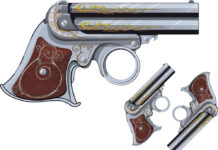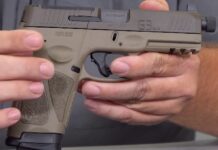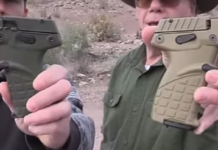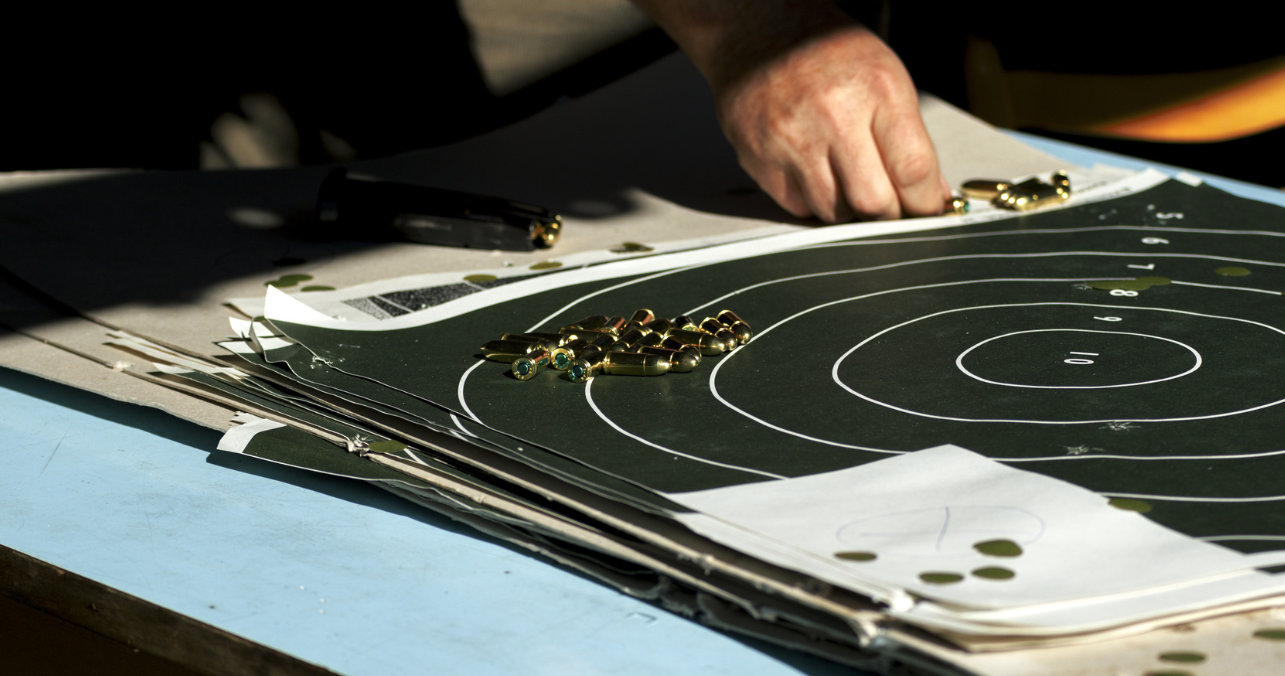![]() During a recent Clandestine Carry Pistol course, at Cowtown Range, in Phoenix, Arizona, one of the students asked me a question that, in one form or another, I am asked at pretty much every class I teach, and in numerous emails weekly. That question is, “What are your favorite training drills?”
During a recent Clandestine Carry Pistol course, at Cowtown Range, in Phoenix, Arizona, one of the students asked me a question that, in one form or another, I am asked at pretty much every class I teach, and in numerous emails weekly. That question is, “What are your favorite training drills?”
It’s a good question, but a tough one to answer, because it requires clarification. How are we defining “favorite?” Are we defining it as the drills I think are fun to shoot, regardless of practice value, or are we looking for the drills I think are most important to successful improvement of my abilities behind the gun? Assuming most interrogators are seeking an answer to the latter, then we have to clarify, what specific aspects are you trying to improve?
Assuming that most are seeking the drills I believe offer the most benefit, across the range of skills needed to employ a firearm in the combative, anti-personnel role, below, I’ve listed my five favorite drills, including why I believe they are important, and a couple ways that some of them can be modified for additional training benefit.
Fundamental Aspects of Combative Shooting
In my classes, books, and articles, I’ve repeatedly made the point that there are three fundamental aspects of employing a firearm in a combative encounter. In the modern world, regardless of context—armed citizen, sworn peace officer, or combat soldier in a war zone—they ALWAYS apply, in this day and age.
1. You need to be able to hit what you need to hit, as many times as necessary, to elicit the desired response. In some cases, it may simply require pointing the gun at the bad guy, or a single shot, delivered anywhere on his body may be adequate. In more extreme cases, three or thirteen rounds to the upper thoracic cavity may be what it takes. In some cases, you may have to take the head shot, or you may have just their knee, hand, or part of their face exposed for the shot. You need to be able to hit, what you need to hit.
2. You need to be able to introduce the gun to the fight, in time for it to play a decisive role in the outcome of the encounter. In a three-second gunfight, having a four-second draw from concealment means, you aren’t in a gunfight…you’re a shooting victim. If an enemy combatant is maneuvering towards you in 3-5 second rushes, and it takes you 6-7 seconds to get into a suitable firing position and fire your carbine, you’re probably going to get beat to death with the butt of his rifle when he finally gets to you.
3. Under physiological stress, you need to be able to achieve 1 and 2, utilizing contextual decision-making regarding who and what you should be shooting, when. If you’ve never tried to shoot more accurately than an entire IDPA silhouette, at 21 feet, but now, you’re presented with a head shot requirement, at 30 feet, guess what? You cannot—responsibly—take that shot. You MIGHT be able to take it, and you MIGHT get lucky enough to get the hit, but making THAT decision is part of number 3. “What is the potential result if I miss, since I am probably going to, never having tried such a difficult shot in practice?” As I point out, ad nauseum, shooting bystanders does not generally solve the problem of stopping an armed, aggressive assailant.
Most of us—all of us really, in the days of cell phone cameras with Internet access built in—do not live in free-fire zones, where we can use a “Mad Minute” of rapid-fire mag dumps in the hope of hitting, or at least “pinning down,” an attacker or hostile belligerent. Even a uniformed serviceman, fighting in a war torn Third World city, if he starts smoke-checking unarmed women and kids, is going to face grievous penalties. We exist in a world where there ARE innocent bystanders, including pregnant mothers and young children. We exist in a world were, even if he was shooting at you moments ago, once a dude drops his gun and “reaches for the sky,” you’d better not shoot; all macho posturing aside, if you shoot him anyway, and there WILL be witness, pre- or post-mortem—and probably video as well—that will be used to ruin your life.
The Fab Five
1. Group Shooting: Whether we call it “group shooting” with the carbine, or “the Dot Drill” with the pistol, I find that wringing out the maximum level of precision and accuracy that we are capable of with the gun, should be the cornerstone of the foundation of good combative shooting. While it is popular in some circles to blather on about “combat accuracy,” and shooting the entire silhouette being “good enough,” it is an old truism in combat marksmanship training, that your accuracy degrades significantly under the physiological stress of a gunfight. Starting with a high level of accuracy and precision gives you more leeway for achieving the three fundamental aspects of combative shooting, if this does happen to you.
2. Snap Drills: I’ve written extensively about the importance of “Snap Drills,” with both carbine and pistol, including a recent article on PreparedGunOwners.com, HERE.
3. The Rhythm Drill/”Bill Drill”: The Rhythm Drill (one variant is called the “Bill Drill,” after Bill Wilson, founder of Wilson Combat, and one of the founders of the International Defensive Pistol Association—IDPA) is an important drill for learning to shoot multiple shot strings quickly and accurately. It is useful for teaching the shooter to find the pace at which they are able to fire, then reacquire a hit picture, make the decision to fire again, and then break the shot, without missing. If we are shooting a very staccato, rhythmless string of fire, in many cases, it may be that we are not managing the gun efficiently. This can range from needing to fix our grip on the gun, to the very real occurrence of we’re not actually seeing our sights on the very quick shots, while we’re taking too long to dial in our sight picture on others. Forcing ourselves to stay on a solid, fast rhythm, in training, teaches us to take the available time to find our sight picture and prep the trigger for the next shot, and then break the shot.
4. VTAC 1-5: This drill gets double billing. Not only do I believe it to be an extremely useful drill for developing a number of significantly important skills, it is also a whole lot of fun to shoot, once you start getting good at it. It is the closest thing to a “mag dump” drill you’ll ever see me run or teach, in a class.
In addition to basically shooting a “rhythm drill” on each individual target, it allows you to practice shooting the same rhythm BETWEEN targets. This forces you to drive the gun from target to target more aggressively, leading to better, faster transitions.
Invariably, in the classes when I remember to have students do it this way, students who run this drill before I teach them to use the rhythm drill on transitions, and then run it again after, we see a noticeable improvement. On the initial runs, students will fire noticeably faster strings on some targets (typically the fourth and fifth target), but—invariably—the overall elapsed time for completing the drill is significantly faster once they begin applying the rhythm drill. Using the Rhythm Drill between targets, as well as on targets leads to faster times on this drill, which allows us to use this to teach and practice a large number of very important skills, in one drill.
In fact, incorporating a mandatory speed reload after the third target, does a really good job of making this drill a spectacular replacement in the training tool box, for the classic “El Prez.” It achieves everything that “El Prez” does—multiple shots on multiple target transitions, at a high rate of speed, and a speed reload to really disrupt the rhythm and timing—while avoiding the major detriment of “El Prez,” namely, hardwiring the “double tap,” “controlled pairs,” or “hammers,” as a default into the shooting program.
I’ve had students who had shot “El Prez” consistently enough to know both their average time and PR time, who ran “El Prez,” and then ran what I jokingly refer to as the “El Prez 1-5,” against each other. Despite firing MORE rounds in “El Prez 1-5,” (15 rounds, versus 12 rounds to run “El Prez,”) and despite using a significantly smaller “A-Zone” (I use 4×6 index cards in classes), they have managed to drop significant time on the “El Prez 1-5” versus the standard “El Prez”…once they had learned to use the Rhythm Drill to their advantage.
5. Third Grade Math: I stole this drill from Frank Proctor, at Way of the Gun, the very first time I saw a video of it being run. In fact, I’ve been using it so long now, I’m not entirely sure I even run it the exact way that Frank prescribes. It is a solid decision-making drill that does a good job of building your ability to perform Fundamental Aspect #3, while executing a shooting problem. It incorporates multiple potentially “correct” solutions, requiring some pretty high-order thinking. If the “sum” numbers are kept low, it is also a relatively inexpensive drill to run, in regard to ammunition, while still being efficient at achieving its purpose.
When I teach it, I use up to 8-9 targets, numbered from 2 and up. I never use a number 1 target anymore, because I found that everyone defaulted to shooting the 1 target, in the quest to make it easier.
One of the two major modifications I use for it is, whether running it with pistol or carbine, I require the shooter to move to a position of cover after the first target has been engaged, before they can engage the second target. For example, the shooter draws, say “8.” She shoots the “2” target twice. Before she can engage the “6,” she has to move to a position of cover. Since I intersperse the targets, randomly, but in pretty tight confines, occasionally, upon moving to a position of cover, she may discover she physically cannot shoot the “6” from there, so she has to maneuver to a new position from which she can.
Another variation I like to incorporate is to have some numbers missing, and multiple targets with the same numbers on them. So, I have ten targets arrayed, numbered 2-9, there are two targets that don’t have numbers on them, right? So, I’ll put numbers on them as well, and from the first eight, I might change 3, and 5. Now, I might have one 2, two 4, two 6, one 7, one 8, and three 9. Now, the shooter draws “8.” They might shoot 2 and 6 (or 6 and 2), or they might shoot two different 4. Both are “correct.” They just have to up their mind about which one they’re going to do, and then do it.
Maybe, they draw 7. How can they shoot two different targets that equal 7, in the array described above? They can’t. So, while almost invariably, a shooter will start out by blasting away at 2, or 4, or even 6, they suddenly realize, there’s no way to complete the drill. Sometimes, they just start blasting away—inexplicably—at some other target. Sometimes, they just go, “Uh, wait, what!?” At least once, I’ve seen a student, in a class, throw down their rifle in disgust and frustration. What is the “correct” solution? Don’t shoot! There is no way, within the context of the drill, to solve the problem with gunfire.
This last example illustrates one method that this drill uses to force students to take in ALL of the available incoming data from the battlespace, BEFORE they start blasting…pretty critical in a world of off-duty LEO and CCW permittees, if you decide to whip out your CCW piece, in response to a shooting event in the real-world, don’t you think? It’s not particularly popular, but I believe it is absolutely morally crucial, for combative shooting trainers to—at least occasionally—incorporate “no shoot” solutions into training classes, especially in an industry where in the typical class, we see every iteration require high-volume, high-speed shooting as the solution to EVERY drill.
So, there you have it…my Fab Five Favorite Drills for training, and practicing the three fundamental aspects of combative shooting.










![What Level Holster Should You Be Using? [Video]](/wp-content/uploads/2024/04/Depositphotos_44548439_S-218x150.jpg)
![Case Study: Defensive Gun Use [Video] NSFW](/wp-content/uploads/2025/07/Depositphotos_282075792_S-218x150.jpg)




















![Optic Ready vs Milled slides? [Video]](/wp-content/uploads/2024/02/image-3-100x70.png)
![[Checklist] What Gear You Need To Take Pistol, Rifle & Shotgun Training Courses [Video]](/wp-content/uploads/2023/07/Depositphotos_275087632_L-100x70.jpg)
![What is in Carter’s 2023 EDC? [Video]](/wp-content/uploads/2023/07/Depositphotos_146856137_L-100x70.jpg)



[…] 2. Five Combative Shooting Drills You MUST Practice […]
Comments are closed.